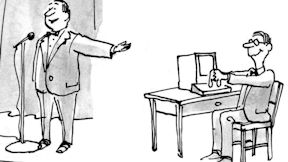|
|
Mobile Marketing 101: What Your Business Needs to Know

Your business already boasts its own interactive Web site. You run a busy blog promoting your company and its services. You Tweet your followers whenever your business is holding special sales or launches a new service or product. Your business’s Facebook page is steadily adding followers.
Unfortunately, to reach today’s consumers, all that isn’t enough. You must also master mobile marketing.
Mobile marketing matters
For time-strapped business owners, this might seem like one too many ways in which to reach consumers. However, today’s customers rely extensively on their smart phones and tablets. If you want to reach them, you have to make sure that they are receiving your marketing messages on their mobile devices.
There are several ways to do this. The most important is to develop a Web site that is optimized for mobile devices. Far too many businesses today boast highly interactive Web sites that look great on a computer screen but cluttered and messy on a tablet or smart phone.
Optimize your site for mobile
And that’s unfortunate. What happens when customers on the road seek an Italian restaurant near them? They’ll log onto your Web site, struggle to read the particulars on their smart phone or tablet, and then search for an alternative, a competitor who might have a Web site that fits nicely in the confines of the smaller screens common to mobile devices.
Savvy businesses today operate both standard and mobile-optimized Web sites, giving consumers the option to visit their mobile sites when they’re accessing them through smart phones or tablets.
Offer your customers value
Business owners can also send short text messages advertising their business and services to mobile devices. It’s important, though, to make sure that your customers actually want this service. You can, for instance, ask your customers to sign up for mobile messages through your Web site. Usually, you’ll have to entice your customers to sign up. You might, for instance, offer savings and discount opportunities in the mobile messages you send out. A beauty salon might send a message to clients that all perms will be 15 percent off on a specific date. A fast-food restaurant might send a message that French fries are free to all mobile customers with an order of $15 or more.
In short, customers don’t want their smart phones and tablets flooded with marketing messages. But if these messages actually offer them something worthwhile – first crack at a newly released movie or book, a discount on their next purchase – your customers will come to appreciate the value in them.
Top ↑
|
Worried about Losing Your PowerPoint presentations? Here are Some Cloud-based Alternatives

When it’s time to create a business presentation, most of us automatically turn to Microsoft PowerPoint. For as long as computers have taken up space in cubicles, PowerPoint has dominated the world of visual-based business presentations.
However, PowerPoint does come with a significant disadvantage: If your hard drive or thumb drive should get corrupted, you might lose that presentation on which you spent hours working. And when that happens, there’s no avoiding that sinking feeling in your gut.
The good news is that there are several Web-based alternatives to PowerPoint. Because you’ll be storing the presentations you make in the cloud, you’ll no longer have to fret over losing or corrupting the drives containing your presentations.
Here, then, is a look at three Web-based alternatives to PowerPoint.
-
Google Docs Presentations: You knew that Google would have its own answer to PowerPoint, and it does with Google Docs Presentations. This program works much like its better known competitor, allowing users to add text, graphics, videos, and links to presentations.
Google Docs Presentations is free, a nice feature, and it’s easy to share presentations online with other users through Google Docs.
-
SlideRocket: Unlike Google’s offering, SlideRocket isn’t free. There’s a reason for this: This is a powerful Web-based presentation program that stands up to Microsoft PowerPoint. It’s far from a clone of PowerPoint and allows users to comment and answer polls in real time. The program also comes with an analytics feature that gives creators at least some idea of which slides are most effective.
This collaborative program also works well with sites such as Flickr or Google Docs. This makes it easy for creators to incorporate live data and content into their slide-show presentations.
-
Zoho Show: Like other alternatives to PowerPoint, Zoho Show comes with all the functions you need to create a solid visual presentation. However, it does offer a neat feature that its competitors don’t: live audio chat. This makes it easy for users to give presentations to clients who are sitting in meeting rooms across the country. It’s also easy for Zoho Show users to embed their presentations in their blogs or Web sites to share the information with a greater number of users.
Like Google Docs Presentation, Zoho Show is free for personal use.
Top ↑
|
Looking for Innovation? Check out These Five Companies

There are certain companies that inspire us, that create the products that change our world. Here, then, is a short list of some of the most innovative companies in the world and how they’ve changed the way we do business, entertain ourselves, and live.
-
Apple: No list of innovative companies would be complete without a mention of Apple. Just look at the tech giant’s record as of late. The company has changed the way we listen to music with the iPod. It’s changed the way we compute with the iPad. It’s also changed the way we view our phones with the iPhone.
What’s next for apple now that its founder Steve Jobs has passed away? It’s hard to imagine a future in which Apple doesn’t remain one of the world’s most innovative companies.
-
PayPal: PayPal has revolutionized the way in which people get paid. Thanks to this service, you can complete a job, invoice a client, and receive payment for your work, all through a simple PayPal account connected to your e-mail. There’s a reason why PayPal remains one of the most successful companies in the world: It provides a service that people need.
-
Google: Remember searching the Internet before Google? We don’t, either. Google, simply put, dominates the Internet-search business, but that’s just the start of Google’s online mastery. The company also boasts such highly popular services as GMail, Google Calendar, and Google Docs. The verdict is still out on Google+, the company’s foray into social media. But with its already impressive track record, it’s difficult to bet against Google succeeding in this arena too.
-
Amazon: There was a time when Amazon.com ranked as the world’s most popular online bookstore. That was innovative enough. Today, though, Amazon has branched out. Consumers can buy just about anything on Amazon today. The company also boasts an impressive tablet computer, the Kindle Fire. It’s also a mainstay in the pay-per-view movie service, allowing consumers to download and watch both the latest releases and older films.
-
Starbucks: Sure, Starbucks is, at its heart, just a coffee shop. But what a coffee shop. Starbucks has thrived by charging far too much for a cup of coffee, and it’s done this without alienating its customers. Can you think of any trendy shopping area that doesn’t boast a Starbucks or two?
Top ↑
|
The Easy Way to Master Google Calendar

There’s a problem with even the most impressive pieces of technology: No matter how powerful they might be, if you don’t know how to use them properly, they’re pretty much useless.
Take Google Calendar as an example. Used properly, this program can help you organize your days, make missed telephone calls and appointments a thing of the past, and boost your efficiency.
But that’s only if you know the Google Calendar shortcuts that can make you a more efficient user.
Fortunately, mastering Google Calendar only requires learning a few easy tricks.
-
Learn those keyboard shortcuts: Like most programs, Google Calendar comes with a host of keyboard-activated shortcuts that will help you move around Calendar more quickly. It may not seem like it, but these shortcuts can save you plenty of time.
For instance, if you hit the “D” key on your keyboard, Google Calendar will display its “Day” display. If you hit the “W” key, the “Week” display will pop up. And if you hit the “M” key, the — you guessed it — “Month” display will show.
-
Changing time zones: How many times have you missed a phone call or online meeting because of time-zone confusion? With Google Calendar’s Time Zone function, you won’t have to worry about this problem again. That’s because Calendar can display several time zones at the same time.
To do this, click on the “S” key on your keyboard. This will bring up Calendar’s “Settings” menu. Click the “General” tab on this menu. Then look for the “Your current time zone” section. Click on the “Show an additional time zone” option. Next, click on the “Display all time zones” option. You can then scroll down a list of time zones to select the ones that you want to display.
-
Turn Calendar into your secretary: So you don’t have a real flesh-and-blood secretary. No problem. You can set up Google Calendar so that it e-mails your agenda to you every day. That way, when you open your e-mail inbox, you’ll have a daily message telling you what’s on your schedule for the day.
To activate this feature, click the “S” key on your keyboard to bring up the “Settings” menu. Click on the “Calendars” tab, and then click the “Notifications” link. If you click the “Daily agenda” option, you’ll receive an e-mail message listing your tasks each day at 5 a.m.
Top ↑
|
When it comes to Predicting the Future? Science-fiction isn’t Bad

We’re still waiting for our personal jet packs, and as far as we know, there aren’t any condos for sale on the moon.
Surprisingly, though, the world of science-fiction has done a solid of predicting the gadgets of the future.
Here’s a quick look at the tech we use today that was first dreamed up in science-fiction novels and movies.
-
Smart robots: Sure, we have plenty of robots. They help us build our cars and vacuum our rugs, but what about smart robots — metal beings that actually learn and show signs of a personality? So far, those are only present in science fiction, but according to a report by the Daily Mail, computer scientist and medical doctor Henry Markram is busy leading the efforts to create a robot that actually learns. The doctor’s prediction? His robot will be complete in 2018.
-
Automatic doors: Today, we take automatic doors for granted. It’s awfully nice to walk out the grocery store and have those glass doors swing open at our approach. However, as the editors at Business Insider point out, author H.G. Wells predicted this technology in his novel When the Sleeper Wakes. Turns out, Wells was prescient when it came to this bit of technology. (Digging to the center of the earth? Well, that one hasn’t come true just yet.)
-
Leaving our atmosphere: It’s difficult to imagine a more amazing achievement than blasting into space. Yet, we’ve become bored with NASA and its exploits. Back in 1961, though, when Yuri Gagarin became the first human in outer space, it was a pretty big deal. Author Jules Vern surely would have appreciated it. He fantasized about outer space travel way back in his novel From the Earth to the Moon, which was published in 1865.
-
Body scanners: Paste Magazine reminds us of that scene in Arnold Schwarzenegger’s Total Recall in which our hero must undergo a full body scan when going through a security checkpoint. These body scans became commonplace at airports across the country starting in 2010.
-
iPads: As Britain’s The Guardian newspaper points out, the seminal science fiction film 2001: A Space Odyssey, correctly predicted much of today’s technology. This includes the film’s astronauts staring into flat video devices, even while eating. Sounds a lot like the iPad
Of course, science-fiction is far from perfect in its crystal ball capabilities. Here are two notable misses from the world of science-fiction:
-
Individual jet packs: This is probably the biggest disappointment. People still aren’t flying around with the help of their own personal jetpacks. We’re still stuck walking.
-
Meals in pill form: Anyone who’s running late for a big meeting can appreciate the meal in a pill. Just pop the pill and you’re full. No mess and no cooking. This, alas, has not yet come to pass. Its fast-food chains for us when we need a quick bite.
Top ↑
|
|






Leave a Reply
Want to join the discussion?Feel free to contribute!